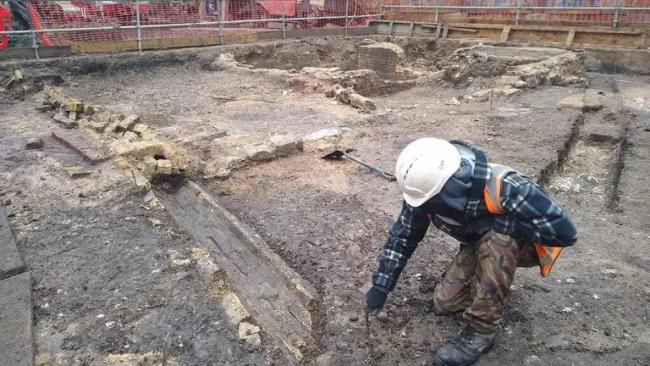
Archaeology at Jesus
As part of the ongoing Kitchen Project, an archaeological excavation in Pump Court has uncovered a cross-section of the College's history. We spoke to Cotswold Archaeology about the results of the dig so far.
"Cotswold Archaeology’s Suffolk team began excavating at Jesus College on 4 January, although the site in Pump Court had been prepared just before Christmas. The preparatory work involved recording the uppermost layers of the site, which consisted of modern garden soils, pathways and drains, before excavating these with a mechanical digger to expose the top of the archaeological remains.
These include the foundations of Alfred Waterhouse’s hall building (constructed in 1875 and demolished in the mid-20th century), the foundations and cellars of what appears to be a building shown on a late 17th century plan and drawing of the College, as well as the remains of 17th–18th century garden soils, walls, wells, culverts, and rubbish pits. In places, hidden between the post-medieval features, we can glimpse even earlier archaeological remains, including what might be the large foundations of a previously unknown wall, perhaps of medieval date.
Because the archaeological remains consist of a complex series of overlapping soil layers, walls, cellars, culverts and pits, the excavation is like a puzzle; we have to approach it by excavating and recording each archaeological feature in turn, starting with the latest and working backwards through time to the earliest. Our initial task was therefore to identify which soil layers, pits or walls were the latest in date, so that we could dig these first.
This undertaking was made slightly easier by the numerous drains, water pipes, gas pipes, manholes, electrical cables, and other services that had been laid across the site over the past 200 years, often buried in deep trenches. While these service trenches had damaged the archaeological remains through which they were dug, we could nevertheless use them to our advantage: by excavating the contents of the modern service trenches first, we could examine their sides and see the archaeological remains that they had cut. This provides us with a valuable window through which we can see how deep the remains are, and the order in which they lie on top of each other (something we call the ‘stratigraphic sequence’).
Our next task was to record and excavate the latest archaeological remains in the sequence, and in doing so uncover earlier features. So far, we have recorded Waterhouse’s 19th century hall structure, a series of post-medieval pits and postholes, a post-medieval well, several post-medieval culverts, and a wall that appears on a 17th century plan of the site.
We have also begun to record and excavate the complex series of post-medieval garden soils and kitchen waste dumps from the early college phases of the site’s history. These are full of oyster shells, animal bone, clay tobacco pipes and broken pieces of pottery; these will help us date each layer and will provide us with important insights into many aspects of life in the College.
Watch out for more updates as excavation progresses!"
This article was originally published on the Cotswold Archeology website.





